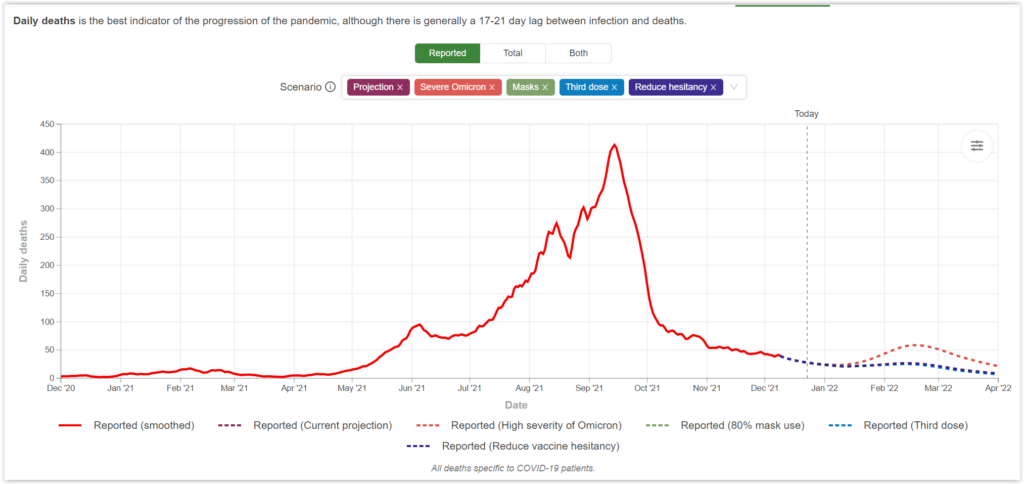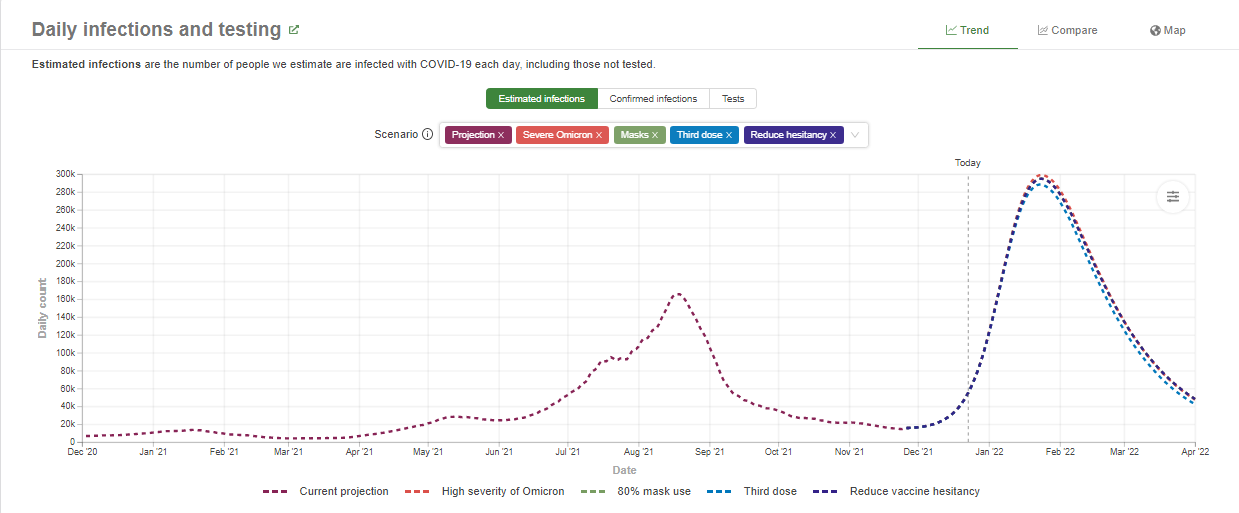KUALA LUMPUR, Dec 23 – The US-based Institute for Health Metrics and Evaluation (IHME) has predicted a sharp rise of Covid-19 cases in Malaysia due to Omicron, with daily infections expected to hit nearly 300,000 by the end of January.
The IHME model, which is widely used globally, projected Omicron to be the dominant variant in Malaysia by December 15, a week ago, and worldwide by January 2022. According to Our World In Data, however, Delta comprised 97.6 per cent of analysed SARS-CoV-2 variants in Malaysia, with Omicron forming 2.4 per cent, as of December 13.
Malaysia’s Ministry of Health (MOH) has officially reported only 13 Omicron cases as of December 18, all imported infections from abroad.
It is likely that Malaysia may not be performing enough genomic sequencing to track Omicron, as Malaysia just sequenced and shared 0.3 per cent, or 1,816, of 581,760 reported Covid-19 cases with the global GISAID database in the last 90 days as of today.
IHME projected 29,304 new Covid-19 cases in Malaysia on December 15, but MOH officially reported 3,900 fresh infections on that date. IHME’s predictions of daily infections are based on the number of people it estimates are infected with Covid-19 each day, including those not tested. IHME estimates nine of 10 Omicron cases to be asymptomatic.
According to a summary of its latest projection, IHME, which is an independent global health research centre at the University of Washington, estimated the current prevalence of Omicron in Malaysia to be between 75 per cent and 89 per cent compared to the Delta variant at 10 per cent to 24 per cent, based on available data as of December 13.
Presuming the IHME is correct and that Omicron is already dominant in the country, Malaysia’s hospitalised cases and intensive care unit (ICU) rates remain low at a weekly daily average of 888 cases and 376 cases respectively, according to the CovidNow website.
To compare, there were over 14,000 hospitalised Covid-19 cases and more than 1,400 Covid-19 patients in ICU in a day (both confirmed and suspected) at the height of the country’s coronavirus crisis in mid-August this year.
According to IHME’s projections, Malaysia will register over 100,000 new Covid-19 infections on December 30, increasing to a peak of 294,682 cases on January 24 next year.
Following that, the US-based model projected a decline in the number of Covid-19 cases in Malaysia to 48,087 new cases on April 1.

Despite the rapid spike in projected Covid-19 infections in Malaysia next month, the IHME projected only a minimal increase in hospitalised patients and cases requiring intensive care in February — suggesting that most cases will unlikely be severe.
The IMHE expected the number of hospital beds needed to more than double from about 500 beds currently to a peak of 1,246 beds on February 20. Last mid-September, IHME projected the need for nearly 8,000 hospital beds.
IMHE’s projection also showed a minimal increase in the number of ICU beds needed from its current estimate of 118 beds to a peak of 282 beds over the same period. Last mid-September, IHME projected the need for about 1,800 ICU beds.

Daily Covid-19 deaths are also expected to see a slight increase to 26 deaths daily in mid-February before declining to eight daily deaths on April 1. The figure, however, is expected to double to 58 cases daily in mid-February if there is high severity of Omicron, before it tapers to about 21 daily deaths on April 1.
Globally, the IMHE projected up to three billion Covid-19 infections over the next three months. It also expected an additional half a million coronavirus deaths by March 2022.
IHME director and lead modeller Dr Christopher J.L. Murray, in sharing insights from the institute’s latest Covid-19 model run yesterday, said it is presumed that fewer Omicron infections are likely to be detected as a larger fraction of Omicron cases will be asymptomatic — about 90 per cent as opposed to 40 per cent of previous variants.
This suggests that fewer people will seek out testing and thus will not have their infections recorded, Murray said.
He said overall hospitalisations and deaths are also projected to be lower than previous surges as the infection-hospitalisation and infection-fatality rates of Omicron are much lower than other variants like Delta.
The infection-hospitalisation rate of Omicron — which is the fraction of infections (including undetected) that end up in hospital, as opposed to the share of reported cases who end up hospitalised — is probably 90 per cent to 96 per cent lower than for Delta. The infection-fatality rate (deaths of those who get infected) is also “dramatically lower” in Omicron compared to Delta at likely 97 per cent to 99 per cent lower, said Dr Murray.
Dr Murray said despite uncertainties about the severity of Omicron, what is known is that boosters make a huge difference to the effectiveness of the immune response.
“So if somebody who is vaccinated gets a booster actually for Omicron, they will go back to having very good protection. Boosters are very important,” he said, in addition to wearing high-quality masks.
“Because Omicron is so transmissible, one should err on the side of a high-quality mask that protects you as well as protecting others. An N95-type mask is an effective mask because we know that health care workers who use personal protective equipment — particularly N95 masks — are not at increased risk, so we know that they work in pretty much all circumstances.
“Then, of course, for those people who have not been vaccinated, getting vaccinated is a critical part of protecting yourself and your family,” he said.
Ali H. Mokdad, chief strategy officer for population health at the University of Washington’s Population Health Institute, in a tweet, said the projection of Covid-19 infections in the next three months is as much as the infections in the past two years.
“Omicron is spreading fast. This will put a lot of pressure on our medical systems. Get your vaccine and wear a mask,” he tweeted.
American epidemiologist Dr Eric Feigl-Ding, in reference to Ali’s statement, tweeted: “Let this sink in — with Omicron, we might be compressing 2 years worth of infections into just 3 months, says @AliHMokdad — an 8:1 time compression ratio! Anyone who doesn’t think hospitals will be overwhelmed is living in fantasy land.”
In another tweet, Dr Feigl-Ding pointed out that hospitalisations in London, UK have tripled since a month ago. He noted that the UK’s per capita incidence after reporting 106,122 new Covid-19 cases yesterday is equivalent to about 515,000 new cases in the US — more than double the all-time record ever seen in the US.








